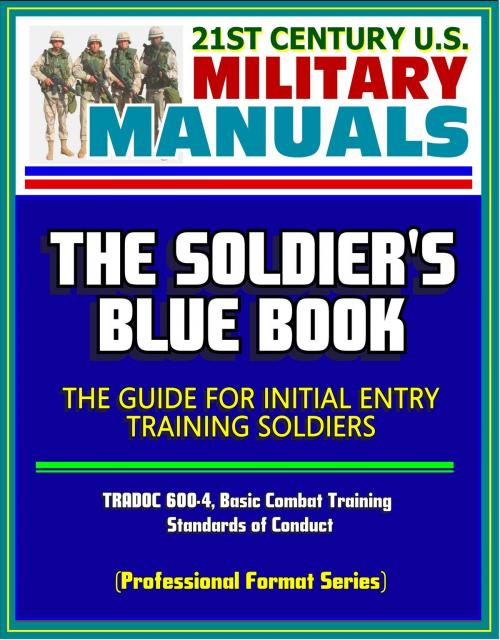21st Century U.S. Military Manuals: The Soldier's Blue Book - The Guide for Initial Entry Training Soldiers, TRADOC 600-4, Basic Combat Training, Standards of Conduct (Professional Format Series)
Nonfiction, History, Military, United States| Author: | Progressive Management | ISBN: | 9781301042395 |
| Publisher: | Progressive Management | Publication: | November 30, 2012 |
| Imprint: | Smashwords Edition | Language: | English |
| Author: | Progressive Management |
| ISBN: | 9781301042395 |
| Publisher: | Progressive Management |
| Publication: | November 30, 2012 |
| Imprint: | Smashwords Edition |
| Language: | English |
Professionally converted for accurate flowing-text e-book format reproduction, The Soldier's Blue Book provides a guide for initial entry training soldiers.
The introductions states: From 1775 until Valley Forge, American forces were brave, but disorganized citizens fighting against highly trained and organized British Soldiers. To win the Revolutionary War, General George Washington's men needed better training, discipline, and esprit de corps.
Seeking a solution, General Washington tasked Baron von Steuben with transforming the large group of hungry and exhausted men at Valley Forge into a disciplined fighting force. In the harsh Pennsylvania winter, Baron von Steuben instructed a company of future leaders in basic military movements and tactical skills; those individuals were the predecessors of our Drill Sergeants! He developed that cadre until they could -in turn—train the entire Revolutionary Army in the art of basic military maneuvers. Through their perseverance and sense of duty, these dedicated troops practiced to the highest standards. As a result, Washington's men fought skillfully in battle and truly embodied a professional army. By 1783, America had won its independence.
Training to standard and gaining the inner strength to adapt and overcome adversity became the theme for our Army's training model. Baron von Steuben, by then the Army Inspector General, wrote the Regulations for the Order and Discipline of the Troops of the United States—now commonly referred to as the Blue Book—as an instructional guide for future generations. This book consists, as our modern version does now, of detailed training procedures, the standards of military conduct, and the fundamentals every Soldier needs to ensure he or she is successful in battle.
Blue Book History * Chapter 1 * Army Transition * Definition of a Soldier * Army Culture * Army History * IET Transformation and Soldierization * BCT Soldier Requirements * Chapter 2 * Army Values * LDRSHIP * Soldier's Creed * Warrior Ethos * Soldier's Rules * Chapter 3 * Basic Combat Training/OSUT * The Buddy System * Phased Training * A Drill Sergeant's Role * Phase I (Red) * Phase II (White) * Phase III (Blue) * Chapter 4 * AIT/OSUT * AIT Soldier Requirements * Phase IV (Black) and Phase V (Gold) * Drill Sergeants and AIT PSGs * Preparation for First Duty Assignment * Appendix A: * Army Knowledge * Army Organization * Chain of Command * Oath of Enlistment * Code of Conduct * Pledge of Allegiance * National Anthem * Declaration of Independence (extract) * Army Song * Bugle Calls * Military Time * Officer Insignia * Warrant Officer Insignia * Enlisted Insignia * Promotions * Guard Duty * General Orders * Drill and Ceremonies * Personal Appearance and Uniform * Customs and Courtesies * Awards and Decorations * Appendix B: * Warrior Tasks and Battle Drills * Shoot * Move * Communicate * Survive * Adapt * Appendix C: * Army Physical Readiness Training * Exercises and Drills * Army Physical Fitness Test (APFT) * Hygiene * Nutrition * Comprehensive Soldier Fitness * Appendix D: * Standards of Conduct * Uniform Code of Military Justice * Standards and Principles of Ethical Conduct * Equal Opportunity Policy * Policy on Relationships between Soldiers * Army Sexual Harassment Policy * Rape and Sexual Assault Prevention * Suicide Prevention * Composite Risk Management * Appendix E: * Army Resources * TRICARE * SGLI * Dental Plan * Leave and Earnings Statement * Managing Personal Finances * Chaplains * Appendix F: * Learning * Appendix G: * Soldier's Notes * Glossary * IET Acronyms * Army Definitions * Information Websites for Family Members
As a bonus, this reproduction includes the complete 2012 Army Leadership manual (FM 6-22), which describes the Army's view of leadership, outlines the levels of leadership (direct, organizational, and strategic), and describes the attributes and core leader competencies across all levels.
Professionally converted for accurate flowing-text e-book format reproduction, The Soldier's Blue Book provides a guide for initial entry training soldiers.
The introductions states: From 1775 until Valley Forge, American forces were brave, but disorganized citizens fighting against highly trained and organized British Soldiers. To win the Revolutionary War, General George Washington's men needed better training, discipline, and esprit de corps.
Seeking a solution, General Washington tasked Baron von Steuben with transforming the large group of hungry and exhausted men at Valley Forge into a disciplined fighting force. In the harsh Pennsylvania winter, Baron von Steuben instructed a company of future leaders in basic military movements and tactical skills; those individuals were the predecessors of our Drill Sergeants! He developed that cadre until they could -in turn—train the entire Revolutionary Army in the art of basic military maneuvers. Through their perseverance and sense of duty, these dedicated troops practiced to the highest standards. As a result, Washington's men fought skillfully in battle and truly embodied a professional army. By 1783, America had won its independence.
Training to standard and gaining the inner strength to adapt and overcome adversity became the theme for our Army's training model. Baron von Steuben, by then the Army Inspector General, wrote the Regulations for the Order and Discipline of the Troops of the United States—now commonly referred to as the Blue Book—as an instructional guide for future generations. This book consists, as our modern version does now, of detailed training procedures, the standards of military conduct, and the fundamentals every Soldier needs to ensure he or she is successful in battle.
Blue Book History * Chapter 1 * Army Transition * Definition of a Soldier * Army Culture * Army History * IET Transformation and Soldierization * BCT Soldier Requirements * Chapter 2 * Army Values * LDRSHIP * Soldier's Creed * Warrior Ethos * Soldier's Rules * Chapter 3 * Basic Combat Training/OSUT * The Buddy System * Phased Training * A Drill Sergeant's Role * Phase I (Red) * Phase II (White) * Phase III (Blue) * Chapter 4 * AIT/OSUT * AIT Soldier Requirements * Phase IV (Black) and Phase V (Gold) * Drill Sergeants and AIT PSGs * Preparation for First Duty Assignment * Appendix A: * Army Knowledge * Army Organization * Chain of Command * Oath of Enlistment * Code of Conduct * Pledge of Allegiance * National Anthem * Declaration of Independence (extract) * Army Song * Bugle Calls * Military Time * Officer Insignia * Warrant Officer Insignia * Enlisted Insignia * Promotions * Guard Duty * General Orders * Drill and Ceremonies * Personal Appearance and Uniform * Customs and Courtesies * Awards and Decorations * Appendix B: * Warrior Tasks and Battle Drills * Shoot * Move * Communicate * Survive * Adapt * Appendix C: * Army Physical Readiness Training * Exercises and Drills * Army Physical Fitness Test (APFT) * Hygiene * Nutrition * Comprehensive Soldier Fitness * Appendix D: * Standards of Conduct * Uniform Code of Military Justice * Standards and Principles of Ethical Conduct * Equal Opportunity Policy * Policy on Relationships between Soldiers * Army Sexual Harassment Policy * Rape and Sexual Assault Prevention * Suicide Prevention * Composite Risk Management * Appendix E: * Army Resources * TRICARE * SGLI * Dental Plan * Leave and Earnings Statement * Managing Personal Finances * Chaplains * Appendix F: * Learning * Appendix G: * Soldier's Notes * Glossary * IET Acronyms * Army Definitions * Information Websites for Family Members
As a bonus, this reproduction includes the complete 2012 Army Leadership manual (FM 6-22), which describes the Army's view of leadership, outlines the levels of leadership (direct, organizational, and strategic), and describes the attributes and core leader competencies across all levels.















